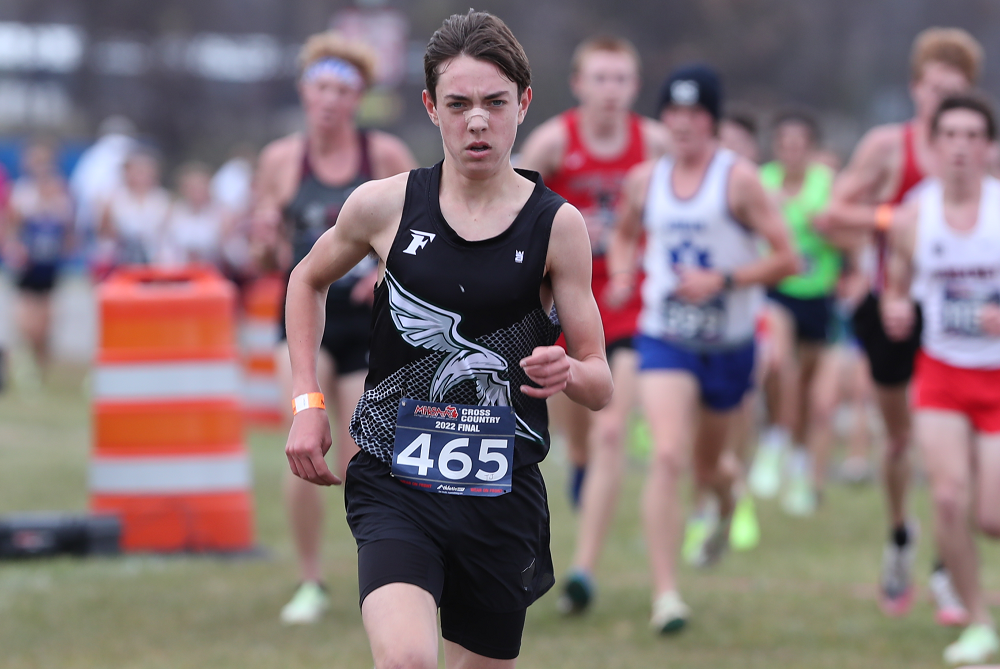
Sturgis XC 'Star' Takes Center Stage
September 8, 2015
By Wes Morgan
Special for Second Half
Daniel Steele became a star in the fifth grade when he played a star in his class’ Christmas production.
Ever since, he’s fed off that adrenaline rush each time the curtain has gone up.
 He’s played Rooster in “Annie Jr.” and the White Rabbit in “Alice In Wonderland.” Steele greedily gobbled goodies as Augustus in “Charlie and the Chocolate Factory.” He was cowman Slim in “Oklahoma” and eventually landed lead roles of Mr. McAfee in “Bye Bye Birdie” and Mr. Browning in “Leaving Iowa” before his most demanding performance as Seymour Krelborn in “Little Shop of Horrors.”
He’s played Rooster in “Annie Jr.” and the White Rabbit in “Alice In Wonderland.” Steele greedily gobbled goodies as Augustus in “Charlie and the Chocolate Factory.” He was cowman Slim in “Oklahoma” and eventually landed lead roles of Mr. McAfee in “Bye Bye Birdie” and Mr. Browning in “Leaving Iowa” before his most demanding performance as Seymour Krelborn in “Little Shop of Horrors.”
Steele said at an early age he was comfortable at the center of attention, which is where he first experienced the joy of putting in work for the payoff of a laugh – and where he learned the importance of precise delivery and timing.
“I feel like I’ve always been a lively person,” the Sturgis High School senior said. “Singing and music have always been a part of my life. It’s something I really love doing.”
One day Steele, who also knows his way around the guitar and clarinet when he’s not leading the Sturgis High School marching band as drum major, hopes to earn a living in entertainment. Most folks, however, know Steele for his rapid ascent in the world of Michigan high school distance running.
That is one of Steele’s talents that materialized his freshman year when he made a decision to be good rather than coast on natural ability.
Believe it or not, Steele said he’s far more nervous stepping up to the starting line at a big meet than delivering a monologue or singing a solo in front of a packed house.
Last season, Steele flirted with a sub-16-minute time for the first half of the season leading up to the Jackson Invitational. He was determined that would be the race where he’d finally break through. He ran a 15:59.5.
“That was one of the biggest things for me as a runner,” he said. “That had been such a big goal for such a long time. That was huge. Achieving something like that kind of opened my eyes like, ‘Hey, if I can do that, I can probably do more.’ It’s going to hurt, but I can do this.”
Steele, last year’s Wolverine Conference champion who is considering running cross country and track at Grand Valley State University, has set the highest of goals for his final season. He’s gone on record saying he will leave Sturgis as the school-record holder, and his aim is to go undefeated.
Keith Keyser, a big supporter of Sturgis athletics, holds the program’s fastest time of 15:36. Before Steele’s third-place finish at the Lower Peninsula Division 2 Finals last year, the best performance by a Sturgis runner at an MHSAA championship race was Keyser’s fifth-place performance in 1981.
“He will be working on his racing technique this year to attack those goals,” Sturgis coach Emerson Green said. “Time improvements are nice, but since cross country times are not linear due to weather, course, competition, etc., he will need to be able to adjust his race strategy based on what the competition yields.”
 That’s something Steele learned the hard way this past March, when he disregarded his targeted first-lap split in the 800-meter MHSAA Final and dropped from first to eighth place on the second lap.
That’s something Steele learned the hard way this past March, when he disregarded his targeted first-lap split in the 800-meter MHSAA Final and dropped from first to eighth place on the second lap.
Pushing his body to the red line too early cost him. Though the experience taught him to implement more method rather than relying solely on guts, old habits are hard to break.
“I can’t feel too bad about it because I really did give it everything I had,” Steele said. “I learned my body is only capable of so much. I want to push myself to the limit, but running is tricky.
“It’s not always consistent and you can’t always go out and give it everything you have and have it work out. The last 200 meters of the race, it was kind of like muscle failure. Everything was falling apart and nothing was working. But I still remember pushing through all of that.”
Green, a chemistry teacher at Sturgis, hopes he can convince Steele that winning races isn’t always about who has the biggest heart.
Steele credits the guidance he’s received from Green, a former college runner at Alma and a 21-year head coach for the Trojans, for helping him grasp the importance of thinking his way through a race and through life.
“I have a lot of respect for Coach Green for how he carries himself as an adult and how he’s helped all of us on the team,” Steele said. “He’s an all-around great guy and really knows what he’s doing. Personally, he’s helped me a ton with his wisdom. Having the experience that he does … and that he’s very personable, it’s easy for me to listen to him and put to good use everything he has to say.”
Every leading man can benefit from a competent supporting actor, and Steele is now being truly pushed in race situations by classmate Shawn Bell, who was 14th at Michigan International Speedway last fall with a time of 16:11.4.
The two finished 1-2 at the St. Joseph Invitational late last month in their only race of the year so far. Steele clocked a 16:25, and Bell crossed the line in 16:29.
“Last year I was kind of training by myself,” Steele said. “I was out in front of the pack in workouts, and in most races I was the frontrunner. Even at the state meet I was pretty much by myself because it was so spread out.
“This year I feel like Shawn has really played a part in the sense that he’s a lot faster now than he was his junior year. He’s made a lot of good steps mentally. He’s a very talented kid; we’ve seen that since middle school. Now he’s really putting in the work and now he’s right up there with me. We’ve been pushing each other like crazy.”
When the cross country season is over, Steele will begin winter workouts for track. Sometimes he uses those hours running around Sturgis to recite lines for the winter musical.
If anyone sees him darting down a sidewalk apparently in mid-conversation, he wants people to know he’s not talking to himself; he’s simply working through a scene.
See below for a video piece on Steele by JoeInsider.com.
 Wes Morgan has reported for the Kalamazoo Gazette, ESPN and ESPNChicago.com, 247Sports and Blue & Gold Illustrated over the last 12 years and is the publisher of JoeInsider.com. He can be reached at [email protected] with story ideas for Berrien, Cass, St. Joseph and Branch counties.
Wes Morgan has reported for the Kalamazoo Gazette, ESPN and ESPNChicago.com, 247Sports and Blue & Gold Illustrated over the last 12 years and is the publisher of JoeInsider.com. He can be reached at [email protected] with story ideas for Berrien, Cass, St. Joseph and Branch counties.
PHOTOS: (Top) Sturgis' Daniel Steele surges past the crowd during his MHSAA Regional race last season. (Middle) Steele rounds the curve at Michigan International Speedway on the way to finishing third in the LP Division 2 Final. (Photos courtesy of the Steele family.)

Freeland's Hansen Not Focused on Joining All-Time Greats - But On His Way
By
Paul Costanzo
Special for MHSAA.com
September 29, 2023
The goal written on Matt Kaczor’s Post-It Note was sub-15 minutes, 15 seconds. That’s what the Freeland cross country coach was hoping for from star runner TJ Hansen during his junior season.
 Kaczor tore it up after seeing Hansen run a single race this fall.
Kaczor tore it up after seeing Hansen run a single race this fall.
“Knowing what he did over the summer and where he was at, seeing what his 1,600 (meter) and his mile got down to, I had a feeling he could get under 15:30 quickly,” Kaczor said. “After the first race, I looked at my assistant and was like, ‘I’ve gotta rip up that Post-It Note. I don’t think our goal is on the level of where he’s at right now.’ At first, it was break 15:15. Once I saw him race at the Under the Lights (on Aug. 18 at St. Johns), I was like, ‘Yeah, he’s going sub 15.’”
Hansen ran 15:39.6 in that first race, and on Sept. 7, in Shepherd, he ran 15:13.9 to meet the goal written on the now-shredded Post-It Note.
This past Saturday, he ran 15:03.7 at the Cadillac Veterans Serving Veterans Invitational. It’s the fastest time recorded in Michigan this year, and a signal that Kaczor might be filling out a new Post-It Note before the season is out.
“The sub-15 barrier, that’s been something on my mind for a while,” Hansen said. “Now that I’m edging closer and closer to that, it’s been exciting. With how heavy my training has been, I wouldn’t expect (to have run this fast this early). Being able to run the times I am really paints the picture for what’s ahead.”
Hansen came into the season already regarded as one of the elite distance runners in the state. He won the 3,200 meters at the MHSAA Lower Peninsula Division 2 Track & Field Finals this past spring. He’s also finished all-state (12th and fifth, respectively) the past two seasons at the LPD2 Cross Country Finals.
His current trajectory, however, would put his name near some of the state’s all-time greats. But that’s not something Hansen is focusing on.
“I really don’t like to compare myself to others,” he said. “I don’t focus on that. I try to be the best TJ Hansen that I can be. The best version of myself.”
Focusing on himself is almost necessary for Hansen, as he’s spending a lot of time during his races running by himself.
At each of the big events Freeland has run in this season, Hansen has finished at least 20 seconds ahead of his nearest competitor. That includes all divisions of the Duane Raffin Festival of Races in Holly.
In Cadillac, where Hansen ran his current best time, he was a full minute ahead of the rest of the field.
 “He’s just a special athlete,” Kaczor said. “I can’t see Freeland having someone like this in a while. He’s a generational talent. What’s crazy is, I had the school record when he was a freshman. He and Braden (Honsinger) broke it last year. But TJ has now dropped that school record (set in 1998) by almost a minute.”
“He’s just a special athlete,” Kaczor said. “I can’t see Freeland having someone like this in a while. He’s a generational talent. What’s crazy is, I had the school record when he was a freshman. He and Braden (Honsinger) broke it last year. But TJ has now dropped that school record (set in 1998) by almost a minute.”
Hansen’s achievements have already put him on a path to run at the next level, which is something of a family tradition.
His older sisters Peyton and Kiera are track & field athletes at Wayne State and Eastern Michigan, respectively. Their parents, Tim and Pam, were track & field stars at Central Michigan.
TJ has drawn the attention of coaches around the country, including from Michigan, Michigan State, Wisconsin, Tennessee and Colorado.
Having family members who know the process is a help for Hansen, and he said they’ve all been good about allowing him to choose his own path, whatever that may be.
“He’s from a good family that knows how to work and knows how to get things done,” Kaczor said. “He knows that if he puts in the work, he’s going to be at a good spot.”
While Hansen admits it can be a bit overwhelming, he’s using it as motivation to run faster and continue to put his name out there.
Also serving as motivation is 2022 Division 2 champion Connell Alford of Chelsea. Alford is among the elite group of runners in Michigan who have broken the 15-minute mark, doing it twice a year ago.
He currently has the state’s second-best time behind Hansen’s this year, running 15:09.1 at the MSU Invitational on Sept. 15.
“Whenever I see him drop a time, my main goal is to run faster,” Hansen said. “Whenever I see him run a good time, that motivates me to work hard.”
The two won’t see each other until the MHSAA Finals on Nov. 4 at Michigan International Speedway. It’s an opportunity Hansen is excited for, as it’s a chance to race and be pushed toward the lofty goals he’s set for himself. Kaczor is excited about it, too, even if it might mean having to replenish his supply of Post-Its.
“We don’t talk about winning the state title; we talk about making sure that we have great races on those days,” Kaczor said. “We can’t control how somebody else runs. It’s a matter of can we, if the weather is right and the course is in good condition, can we be one of the few guys that has run in the 14s on that course? That’s the goal. Put yourself in some great categories with those upper echelons and the greats of all-time.”
 Paul Costanzo served as a sportswriter at The Port Huron Times Herald from 2006-15, including three years as lead sportswriter, and prior to that as sports editor at the Hillsdale Daily News from 2005-06. He can be reached at [email protected] with story ideas for Genesee, Lapeer, St. Clair, Sanilac, Huron, Tuscola, Saginaw, Bay, Arenac, Midland and Gladwin counties.
Paul Costanzo served as a sportswriter at The Port Huron Times Herald from 2006-15, including three years as lead sportswriter, and prior to that as sports editor at the Hillsdale Daily News from 2005-06. He can be reached at [email protected] with story ideas for Genesee, Lapeer, St. Clair, Sanilac, Huron, Tuscola, Saginaw, Bay, Arenac, Midland and Gladwin counties.
PHOTOS (Top) Freeland's TJ Hansen leads a pack during last season's LPD2 Final at Michigan International Speedway. (Middle) Hansen enjoys a moment of exhilaration after winning the 3,200 this spring at the LPD2 Finals at Ada Forest Hills Eastern. (Top photo by Carter Sherline/Run Michigan; middle photo by Dave McCauley/Run Michigan.)

